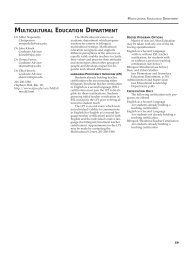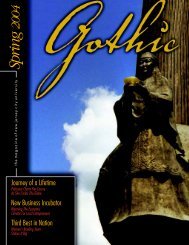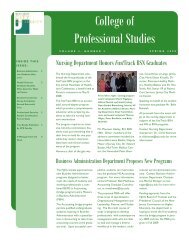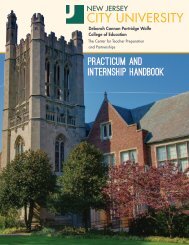Spanish II Curriculum Revised
Spanish II Curriculum Revised
Spanish II Curriculum Revised
You also want an ePaper? Increase the reach of your titles
YUMPU automatically turns print PDFs into web optimized ePapers that Google loves.
Unit Overview: Unit 1:Estados Unidos – Pasatiempos, ¿Qué prefieres ¿Viste las noticias<br />
Content Area: Foreign Language<br />
Target Course/Grade Level: <strong>Spanish</strong> <strong>II</strong> / 11 TH -12 TH Grade<br />
Duration: 9 weeks<br />
Unit Summary<br />
This unit is to introduce the everyday <strong>Spanish</strong> vocabulary that the student might use greet and<br />
introduce others, say where people are from, describe clothing and family, comment on airplane<br />
travel and discuss fine art. The information is to be presented in such a manner that the students<br />
can relate their language learning to everyday life.<br />
Primary interdisciplinary connections:<br />
Art: Comparing art forms and artists<br />
Journalism: Comparing news in <strong>Spanish</strong> and English<br />
Mathematics: Creating graphs based on surveys in <strong>Spanish</strong><br />
21 st century themes: Creativity and Innovation, Critical Thinking and Problem Solving,<br />
Communication and Collaboration, Life and Career Skills<br />
Service learning: N/A<br />
Unit Rationale<br />
This Unit focuses on authentic culture and real-life communication using <strong>Spanish</strong> in Los Angeles,<br />
Chicago and Miami. Students will practice reading writing, listening, and speaking in <strong>Spanish</strong> while<br />
learning about the cultures in the aforementioned cities. By completing activities, students will<br />
apply critical thinking skills as they compare the <strong>Spanish</strong> language and culture of these cities with<br />
those of their own community. They will also connect to other academic subjects, using their<br />
knowledge of <strong>Spanish</strong> to access new information.<br />
Learning Targets<br />
NATIONAL STANDARDS FOR FOREIGN LANGUAGE LEARNING<br />
COMMUNICATION<br />
Communicate in Languages Other Than English<br />
Standard 1.1: Students engage in conversations, provide and obtain information, express feelings<br />
and emotions, and exchange opinions<br />
Standard 1.2: Students understand and interpret written and spoken language on a variety of<br />
topics<br />
Standard 1.3: Students present information, concepts, and ideas to an audience of listeners or<br />
readers on a variety of topics.<br />
CULTURES<br />
Gain Knowledge and Understanding of Other Cultures<br />
Standard 2.1: Students demonstrate an understanding of the relationship between the practices<br />
and perspectives of the culture studied<br />
Standard 2.2: Students demonstrate an understanding of the relationship between the products and<br />
perspectives of the culture studied<br />
CONNECTIONS<br />
Connect with Other Disciplines and Acquire Information<br />
Standard 3.1: Students reinforce and further their knowledge of other disciplines through the
foreign language<br />
Standard 3.2: Students acquire information and recognize the distinctive viewpoints that are only<br />
available through the foreign language and its cultures<br />
COMPARISONS<br />
Develop Insight into the Nature of Language and Culture<br />
Standard 4.1: Students demonstrate understanding of the nature of language through comparisons<br />
of the language studied and their own<br />
Standard 4.2: Students demonstrate understanding of the concept of culture through comparisons<br />
of the cultures studied and their own.<br />
COMMUNITIES<br />
Participate in Multilingual Communities at Home & Around the World<br />
Standard 5.1: Students use the language both within and beyond the school setting<br />
Standard 5.2: Students show evidence of becoming life-long learners by using the language for<br />
personal enjoyment and enrichment.<br />
CPI # Cumulative Progress Indicator (CPI)<br />
7.1 NM A.1 Recognize familiar words and phrases, understand the main idea, and infer the<br />
meaning of some highly contextualized, unfamiliar spoken or written words<br />
contained in culturally authentic materials using electronic information<br />
sources related to targeted themes.<br />
7.1 NM A.2 Demonstrate comprehension of a series of oral and written directions,<br />
commands, and requests through appropriate physical response.<br />
7.1 NM A.3 Recognize some common gestures and cultural practices associated with target<br />
culture(s).<br />
7.1 NM A.4 Identify people, places, objects, and activities in daily life based on oral or<br />
written descriptions.<br />
7.1 NM A.5 Demonstrate comprehension of short conversations and brief written messages<br />
on familiar topics.<br />
7.1 NM A.6 Identify the main idea and other significant ideas in readings from age- and<br />
level-appropriate, culturally authentic materials.<br />
7.1 NM B.1 Use digital tools to exchange basic information at the word and memorizedphrase<br />
level related to self and targeted themes.<br />
7.1 NM B.2 Give and follow simple oral and written directions, commands, and requests<br />
when participating in age-appropriate classroom and cultural activities.<br />
7.1 NM B.3 Imitate appropriate gestures and intonation of the target culture(s)/language<br />
during greetings, leave-takings, and daily interactions.<br />
7.1 NM B.4 Ask and respond to simple questions, make requests, and express preferences<br />
using memorized words and phrases.
7.1 NM B.5 Converse on a variety of familiar topics and/or topics studied in other content<br />
areas.<br />
7.1 NM C.1 Use basic information at the word and memorized-phrase level to<br />
create a multimedia-rich presentation on targeted themes to be shared<br />
virtually with a target language audience.<br />
7.1 NM C.2 Imitate, recite, and/or dramatize simple poetry, rhymes, songs, and<br />
skits.<br />
7.2 NM C.3 Copy/write words, phrases, or simple guided texts on familiar topics.<br />
7.2 NM C.4 Present information from age- and level-appropriate, culturally<br />
authentic materials orally or in writing.<br />
7.2 NM C.5 Name and label tangible cultural products and imitate cultural<br />
practices from the target culture(s).<br />
Unit Essential Questions<br />
• In what ways would learning a foreign<br />
language be beneficial<br />
• How is <strong>Spanish</strong> like and unlike English<br />
Unit Learning Targets<br />
Students will use new vocabulary words in order to:<br />
• talk about where you went and what you did<br />
• discuss leisure time<br />
• comment on airplane travel<br />
• comment on food<br />
• talk about the past<br />
• express activity preferences<br />
• discuss fine art, react to news<br />
• ask for and give information<br />
• talk about things and people you know<br />
Evidence of Learning <br />
Summative Assessment<br />
Tests<br />
Quizzes<br />
Unit Enduring Understandings<br />
• Students will understand the differences<br />
between classroom rules and customs<br />
from other countries with those of their<br />
own.<br />
Equipment needed: Computer, Overhead Projector, Transparencies, Projector<br />
Teacher Resources:<br />
KEY MATERIALS: En Español Dos- McDougal Littell<br />
ACTFL-American Council on the Teaching of Foreign Languages<br />
NJ Department of Education<br />
SUGGESTED SUPPLEMENTARY MATERIALS:<br />
Internet Activities-classzone.com<br />
www.miscositas.com
¿Qué tal Scholastic Magazine<br />
National Geographic en Español<br />
ESPN en Español<br />
Muy Interesante Magazine<br />
CD Rom- En Español<br />
Teacher Resource Books<br />
Supplemental workbooks, videos, CD’s and activity worksheets<br />
Formative Assessments<br />
• Show comprehension of language<br />
through reading authentic and<br />
classroom texts.<br />
• Listen to <strong>Spanish</strong> from a variety<br />
of sources.<br />
• Weekly reading of short text.<br />
• Show comprehension of language<br />
through acting out stories.<br />
• Listen to <strong>Spanish</strong> from variety of<br />
sources.<br />
• Recitation or singing of poems,<br />
songs, etc.<br />
• Show comprehension of language<br />
through acting out stories.<br />
• Creation of oral presentations to<br />
the class.<br />
• Show comprehension of the<br />
language through creating<br />
original conversations and<br />
stories.<br />
• Introduction skits<br />
• Show comprehension of language<br />
through creating original<br />
conversations and stories,<br />
written and oral.<br />
• Creation of short notes or<br />
letters.<br />
• Creation of Powerpoint<br />
presentations.<br />
• Show comprehension of the<br />
language through creating written<br />
original conversations and stories.<br />
• Writing topics: Extra Curricular<br />
Activities<br />
• Extracurricular Activities Project<br />
• Television Morning Show Project<br />
• Storytelling: favorite trips<br />
• Writing assignments in the target<br />
language.<br />
• Performance of skits and stories in<br />
the target language.<br />
• Conversations with the teacher<br />
• Oral presentations and speeches<br />
• Group discussions<br />
• Poster and other projects<br />
• TPRS Assessments:<br />
• Visual check of actions (accuracy<br />
and speed<br />
• Personalized questions and answers<br />
• Putting vocabulary into stories /<br />
retelling stories<br />
• Timed free-writes<br />
Lesson Plans <br />
Lesson<br />
Timeframe<br />
Lesson 1<br />
50 minutes<br />
Leisure Time and Airplane Travel<br />
Lesson 2<br />
50 minutes<br />
Leisure Time and Airplane Travel<br />
Lesson 3<br />
50 minutes<br />
Regular Past Tense Verbs<br />
Other Suggested Activities:<br />
Use the activating question ¿Qué te gusta hacer to present new vocabulary words, asking<br />
students to choose an answer from the text.<br />
Postcard Activity: Give each student a strip of paper with a name of a classmate clearly
written on it. Have students write a postcard to the student named and put them in a class<br />
mailbox.<br />
Plan Ahead your Vacation: Have students write out names of vacation spots on individual<br />
strips of paper. Ask each student to choose a “Vacation Strip” and list the items needed at<br />
the airport in order to reach that destination.<br />
Peer Teaching: have the class list the names of famous <strong>Spanish</strong> speakers on the board.<br />
Working in pairs, one person takes the role of a famous person and the other person<br />
interviews this person about his/her lifestyle, works, accomplishments, and fame.<br />
Teacher Notes:<br />
Unit Overview: Unit 2 Ciudad de Mexico- Ayer y Hoy, Había una vez, Hoy en la<br />
ciudad<br />
Content Area: Foreign Language<br />
Target Course/Grade Level: <strong>Spanish</strong> <strong>II</strong> / 11 TH -12 TH Grade<br />
Duration: 8 weeks<br />
Unit Summary<br />
This unit provide the opportunity to describe childhood experiences, express personal reactions,<br />
discuss family relationships, narrate in the past, discuss family celebrations, talk about activities in<br />
progress, order in a restaurant, and talk about things in the city.<br />
Primary interdisciplinary connections:<br />
• Social Studies: Learning about the Aztec Calendar<br />
• Art: Murals in Mexico<br />
21 st century themes: Creativity and Innovation, Critical Thinking and Problem Solving,<br />
Communication and Collaboration, Life and Career Skills<br />
Service learning: N/A<br />
Unit Rationale<br />
This Unit allows students the opportunity to share information about their current<br />
lives and their past experiences. It encourages students to relate information to<br />
what they know best, themselves, and then learn about others. Students are given<br />
opportunities to learn about a language system employ critical thinking skills while<br />
learning strategies for communicationg and practicing oral and written language.<br />
Learning Targets<br />
NATIONAL STANDARDS FOR FOREIGN LANGUAGE LEARNING<br />
COMMUNICATION<br />
Communicate in Languages Other Than English<br />
Standard 1.1: Students engage in conversations, provide and obtain information, express feelings<br />
and emotions, and exchange opinions<br />
Standard 1.2: Students understand and interpret written and spoken language on a variety of<br />
topics<br />
Standard 1.3: Students present information, concepts, and ideas to an audience of listeners or
eaders on a variety of topics.<br />
CULTURES<br />
Gain Knowledge and Understanding of Other Cultures<br />
Standard 2.1: Students demonstrate an understanding of the relationship between the practices<br />
and perspectives of the culture studied<br />
Standard 2.2: Students demonstrate an understanding of the relationship between the products and<br />
perspectives of the culture studied<br />
CONNECTIONS<br />
Connect with Other Disciplines and Acquire Information<br />
Standard 3.1: Students reinforce and further their knowledge of other disciplines through the<br />
foreign language<br />
Standard 3.2: Students acquire information and recognize the distinctive viewpoints that are only<br />
available through the foreign language and its cultures<br />
COMPARISONS<br />
Develop Insight into the Nature of Language and Culture<br />
Standard 4.1: Students demonstrate understanding of the nature of language through comparisons<br />
of the language studied and their own<br />
Standard 4.2: Students demonstrate understanding of the concept of culture through comparisons<br />
of the cultures studied and their own.<br />
COMMUNITIES<br />
Participate in Multilingual Communities at Home & Around the World<br />
Standard 5.1: Students use the language both within and beyond the school setting<br />
Standard 5.2: Students show evidence of becoming life-long learners by using the language for<br />
personal enjoyment and enrichment.<br />
CPI # Cumulative Progress Indicator (CPI)<br />
7.1 NM A.1 Recognize familiar words and phrases, understand the main idea, and infer the<br />
meaning of some highly contextualized, unfamiliar spoken or written words<br />
contained in culturally authentic materials using electronic information<br />
sources related to targeted themes.<br />
7.1 NM A.2 Demonstrate comprehension of a series of oral and written directions,<br />
commands, and requests through appropriate physical response.<br />
7.1 NM A.3 Recognize some common gestures and cultural practices associated with target<br />
culture(s).<br />
7.1 NM A.4 Identify people, places, objects, and activities in daily life based on oral or<br />
written descriptions.<br />
7.1 NM A.5 Demonstrate comprehension of short conversations and brief written messages<br />
on familiar topics.<br />
7.1 NM A.6 Identify the main idea and other significant ideas in readings from age- and<br />
level-appropriate, culturally authentic materials.<br />
7.1 NM B.1 Use digital tools to exchange basic information at the word and memorizedphrase<br />
level related to self and targeted themes.<br />
7.1 NM B.2 Give and follow simple oral and written directions, commands, and requests<br />
when participating in age-appropriate classroom and cultural activities.
7.1 NM B.3 Imitate appropriate gestures and intonation of the target culture(s)/language<br />
during greetings, leave-takings, and daily interactions.<br />
7.1 NM B.4 Ask and respond to simple questions, make requests, and express preferences<br />
using memorized words and phrases.<br />
7.1 NM B.5 Converse on a variety of familiar topics and/or topics studied in other content<br />
areas.<br />
7.1 NM C.1 Use basic information at the word and memorized-phrase level to<br />
create a multimedia-rich presentation on targeted themes to be shared<br />
virtually with a target language audience.<br />
7.1 NM C.2 Imitate, recite, and/or dramatize simple poetry, rhymes, songs, and<br />
skits.<br />
7.2 NM C.3 Copy/write words, phrases, or simple guided texts on familiar topics.<br />
7.2 NM C.4 Present information from age- and level-appropriate, culturally<br />
authentic materials orally or in writing.<br />
7.2 NM C.5 Name and label tangible cultural products and imitate cultural<br />
practices from the target culture(s).<br />
Unit Essential Questions<br />
• How do people celebrate in <strong>Spanish</strong><br />
speaking countries<br />
• How does this differ from your<br />
celebration<br />
Unit Enduring Understandings<br />
• Students will understand the<br />
differences between special events in<br />
<strong>Spanish</strong>-speaking countries and the<br />
United States<br />
Unit Learning Targets<br />
Students will use new vocabulary words in order to:<br />
• describe childhood experiences<br />
• express personal reactions<br />
• discuss family relationships and celebrations<br />
• narrate the past<br />
• talk about activities in progress<br />
• order in the restaurant<br />
• ask and pay a restaurant bill, talk about things to do in the city<br />
Evidence of Learning <br />
Summative Assessment<br />
Tests<br />
Quizzes<br />
Equipment needed: Computer, Overhead Projector, Transparencies, Projector<br />
Teacher Resources:<br />
KEY MATERIALS: En Español Dos- McDougal Littell<br />
ACTFL-American Council on the Teaching of Foreign Languages<br />
NJ Department of Education<br />
SUGGESTED SUPPLEMENTARY MATERIALS:<br />
Internet Activities-classzone.com<br />
www.miscositas.com<br />
¿Qué tal Scholastic Magazine<br />
National Geographic en Español
ESPN en Español<br />
Muy Interesante Magazine<br />
CD Rom- En Español<br />
Teacher Resource Books<br />
Supplemental workbooks, videos, CD’s and activity worksheets<br />
Formative Assessments<br />
• Show comprehension of language<br />
through reading authentic and<br />
classroom texts.<br />
• Listen to <strong>Spanish</strong> from a variety<br />
of sources.<br />
• Weekly reading of short text.<br />
• Show comprehension of language<br />
through acting out stories.<br />
• Listen to <strong>Spanish</strong> from variety of<br />
sources.<br />
• Recitation or singing of poems,<br />
songs, etc.<br />
• Show comprehension of language<br />
through acting out stories.<br />
• Creation of oral presentations to<br />
the class.<br />
• Show comprehension of the<br />
language through creating<br />
original conversations and<br />
stories.<br />
• Introduction skits<br />
• Show comprehension of language<br />
through creating original<br />
conversations and stories,<br />
written and oral.<br />
• Creation of short notes or<br />
letters.<br />
• Creation of Powerpoint<br />
presentations<br />
Lesson Plans <br />
Lesson<br />
Lesson 1<br />
Childhood experiences, Personal reactions<br />
and Family relationships<br />
Lesson 2<br />
Childhood experiences, Personal reactions<br />
and Family relationships<br />
• Show comprehension of the<br />
language through creating written<br />
original conversations and stories.<br />
• Writing topics: “Quinceañera” Project<br />
o Planning a party Project<br />
o Create a birthday greeting card<br />
• Extracurricular Activities Project<br />
• Storytelling: favorite birthday<br />
party<br />
• Writing assignments in the target<br />
language.<br />
• Performance of skits and stories in<br />
the target language.<br />
• Conversations with the teacher<br />
• Oral presentations and speeches<br />
• Group discussions<br />
• Poster and other projects<br />
• Conventional tests and quizzes<br />
• TPRS Assessments:<br />
• Visual check of actions (accuracy<br />
and speed<br />
• Personalized questions and answers<br />
• Putting vocabulary into stories /<br />
retelling stories<br />
• Timed free-writes<br />
Timeframe<br />
50 minutes<br />
50 minutes<br />
Lesson 3<br />
50 minutes<br />
Imperfect Tense<br />
Other Suggested Activities:<br />
Have students design an invitation in <strong>Spanish</strong> to the class birthday party.
Students will create a page in their “daily planner.” They can describe the present<br />
progressive and describe a day in the past using the past progressive.<br />
Description of family event: Students describe a family member’s event they have attended<br />
recently.<br />
Teacher Notes:<br />
Unit Overview: Unit: 3- San Juan, P.R.- ¿Estás en forma Preparaciones,<br />
¿Cómo te sientes<br />
Content Area: Foreign Language<br />
Target Course/Grade Level: <strong>Spanish</strong> <strong>II</strong> / 11 TH -12 TH Grade<br />
Duration: 9 weeks<br />
Unit Summary<br />
In this unit students will be exposed to the culture of Puerto Rico. Students will discuss ways to stay<br />
fit and healthy, make suggestions, talk about daily routine and personal care, discuss beach<br />
activities, tell someone what to do, talk about chores, describe time periods, talk about health,<br />
illness, and give advice.<br />
Primary interdisciplinary connections:<br />
• Science: Investigating Puerto Rico’s Bahia Fosforescente<br />
• History: Learning about the history of pirates<br />
21 st century themes: Creativity and Innovation, Critical Thinking and Problem Solving,<br />
Communication and Collaboration, Life and Career Skills<br />
Service learning: N/A<br />
Unit Rationale<br />
Encourages students to reflect on how they spend their leisure time and how their choices can help<br />
lead a healthy. It provides a good opportunity for teachers to reinforce that learning a language<br />
involves not only linguistic and cultural components, but also the opportunity to connect with other<br />
disciplines.<br />
Learning Targets<br />
NATIONAL STANDARDS FOR FOREIGN LANGUAGE LEARNING<br />
COMMUNICATION<br />
Communicate in Languages Other Than English<br />
Standard 1.1: Students engage in conversations, provide and obtain information, express feelings<br />
and emotions, and exchange opinions<br />
Standard 1.2: Students understand and interpret written and spoken language on a variety of<br />
topics<br />
Standard 1.3: Students present information, concepts, and ideas to an audience of listeners or<br />
readers on a variety of topics.<br />
CULTURES<br />
Gain Knowledge and Understanding of Other Cultures<br />
Standard 2.1: Students demonstrate an understanding of the relationship between the practices<br />
and perspectives of the culture studied<br />
Standard 2.2: Students demonstrate an understanding of the relationship between the products and
perspectives of the culture studied<br />
CONNECTIONS<br />
Connect with Other Disciplines and Acquire Information<br />
Standard 3.1: Students reinforce and further their knowledge of other disciplines through the<br />
foreign language<br />
Standard 3.2: Students acquire information and recognize the distinctive viewpoints that are only<br />
available through the foreign language and its cultures<br />
COMPARISONS<br />
Develop Insight into the Nature of Language and Culture<br />
Standard 4.1: Students demonstrate understanding of the nature of language through comparisons<br />
of the language studied and their own<br />
Standard 4.2: Students demonstrate understanding of the concept of culture through comparisons<br />
of the cultures studied and their own.<br />
COMMUNITIES<br />
Participate in Multilingual Communities at Home & Around the World<br />
Standard 5.1: Students use the language both within and beyond the school setting<br />
Standard 5.2: Students show evidence of becoming life-long learners by using the language for<br />
personal enjoyment and enrichment.<br />
CPI # Cumulative Progress Indicator (CPI)<br />
7.1 NM A.1 Recognize familiar words and phrases, understand the main idea, and infer the<br />
meaning of some highly contextualized, unfamiliar spoken or written words<br />
contained in culturally authentic materials using electronic information<br />
sources related to targeted themes.<br />
7.1 NM A.2 Demonstrate comprehension of a series of oral and written directions,<br />
commands, and requests through appropriate physical response.<br />
7.1 NM A.3 Recognize some common gestures and cultural practices associated with target<br />
culture(s).<br />
7.1 NM A.4 Identify people, places, objects, and activities in daily life based on oral or<br />
written descriptions.<br />
7.1 NM A.5 Demonstrate comprehension of short conversations and brief written messages<br />
on familiar topics.<br />
7.1 NM A.6 Identify the main idea and other significant ideas in readings from age- and<br />
level-appropriate, culturally authentic materials.<br />
7.1 NM B.1 Use digital tools to exchange basic information at the word and memorizedphrase<br />
level related to self and targeted themes.<br />
7.1 NM B.2 Give and follow simple oral and written directions, commands, and requests<br />
when participating in age-appropriate classroom and cultural activities.<br />
7.1 NM B.3 Imitate appropriate gestures and intonation of the target culture(s)/language<br />
during greetings, leave-takings, and daily interactions.<br />
7.1 NM B.4 Ask and respond to simple questions, make requests, and express preferences<br />
using memorized words and phrases.<br />
7.1 NM B.5 Converse on a variety of familiar topics and/or topics studied in other content<br />
areas.
7.1 NM C.1 Use basic information at the word and memorized-phrase level to<br />
create a multimedia-rich presentation on targeted themes to be shared<br />
virtually with a target language audience.<br />
7.1 NM C.2 Imitate, recite, and/or dramatize simple poetry, rhymes, songs, and<br />
skits.<br />
7.2 NM C.3 Copy/write words, phrases, or simple guided texts on familiar topics.<br />
7.2 NM C.4 Present information from age- and level-appropriate, culturally<br />
authentic materials orally or in writing.<br />
7.2 NM C.5 Name and label tangible cultural products and imitate cultural<br />
practices from the target culture(s).<br />
Unit Essential Questions<br />
What effect do Hispanics have in sports<br />
How do you express feelings in <strong>Spanish</strong><br />
Unit Enduring Understandings<br />
Students will understand the differences<br />
between the daily routine and customs from<br />
other countries with those of their own.<br />
Unit Learning Targets<br />
Students will use new vocabulary words in order to:<br />
• discuss ways to stay fit and healthy<br />
• make suggestions<br />
• talk about daily routine and personal care<br />
• discuss beach activities<br />
• tell someone what to do<br />
• talk about chores<br />
• say if something has already been done<br />
• describe time periods<br />
• talk about health and illness<br />
• give advice<br />
Evidence of Learning <br />
Summative Assessment<br />
Tests<br />
Quizzes<br />
Equipment needed: Computer, Overhead Projector, Transparencies, Projector<br />
Teacher Resources:<br />
KEY MATERIALS: En Español Dos- McDougal Littell<br />
ACTFL-American Council on the Teaching of Foreign Languages<br />
NJ Department of Education<br />
SUGGESTED SUPPLEMENTARY MATERIALS:<br />
Internet Activities-classzone.com<br />
www.miscositas.com<br />
¿Qué tal Scholastic Magazine<br />
National Geographic en Español<br />
ESPN en Español<br />
Muy Interesante Magazine<br />
CD Rom- En Español<br />
Teacher Resource Books<br />
Supplemental workbooks, videos, CD’s and activity worksheets
Formative Assessments<br />
• Show comprehension of language<br />
through reading authentic and<br />
classroom texts.<br />
• Listen to <strong>Spanish</strong> from a variety<br />
of sources.<br />
• Weekly reading of short text.<br />
• Show comprehension of language<br />
through acting out stories.<br />
• Listen to <strong>Spanish</strong> from variety of<br />
sources.<br />
• Recitation or singing of poems,<br />
songs, etc.<br />
• Show comprehension of language<br />
through acting out stories.<br />
• Creation of oral presentations to<br />
the class.<br />
• Show comprehension of the<br />
language through creating<br />
original conversations and<br />
stories.<br />
• Introduction skits<br />
• Show comprehension of language<br />
through creating original<br />
conversations and stories,<br />
written and oral.<br />
• Creation of short notes or<br />
letters.<br />
Lesson Plans <br />
Lesson<br />
Lesson 1<br />
Stay Fit and Healthy, Make Suggestions, Talk<br />
about Daily Routine and Personal care<br />
Lesson 2<br />
Stay Fit and Healthy, Make Suggestions, Talk<br />
about Daily Routine and Personal care<br />
Lesson 3<br />
Affirmative tu commands<br />
• Creation of Powerpoint<br />
presentations<br />
• Show comprehension of the<br />
language through creating written<br />
original conversations and stories.<br />
• Writing topics: A day in “El Yunque”<br />
the Rainforest<br />
• Extracurricular Activities Project<br />
• Storytelling: A Day at the beach<br />
• Writing assignments in the target<br />
language.<br />
• Performance of skits and stories in<br />
the target language.<br />
• Conversations with the teacher<br />
• Oral presentations and speeches<br />
• Group discussions<br />
• Poster and other projects<br />
• Conventional tests and quizzes<br />
• TPRS Assessments:<br />
• Visual check of actions (accuracy<br />
and speed<br />
• Personalized questions and answers<br />
• Putting vocabulary into stories /<br />
retelling stories<br />
• Timed free-writes<br />
Timeframe<br />
50 minutes<br />
50 minutes<br />
50 minutes<br />
Other Suggested Activities:<br />
If any of your students know how to dance “merengue”, “salsa” or “bachata” have them<br />
bring in music and demonstrate for the class.<br />
Have students write a list of suggestions for their school principal to create a better learning<br />
environment.<br />
Teacher Notes:
Unit Overview: Unit: 4 Madrid, España – En la pensión, Conoce la ciudad,<br />
Vamos de compras<br />
Content Area: Foreign Language<br />
Target Course/Grade Level: <strong>Spanish</strong> <strong>II</strong> / 11 TH -12 TH Grade<br />
Duration: 8-9 weeks<br />
Unit Summary<br />
This unit focuses on travel plans, describing rooms, furniture, and appliances. It also describes your<br />
own city, makes suggestions, asks and gives directions, talks about shopping for clothes, makes<br />
comparisons and discusses ways to save and spend money. Students will visit “El Museo del Prado”<br />
via internet. Students will write a paragraph describing the work of art they most enjoyed in their<br />
investigation.<br />
Primary interdisciplinary connections:<br />
• Art: Finding out about artists of the <strong>Spanish</strong> School<br />
• Technology: Creating a Web page for your community<br />
21 st century themes: Creativity and Innovation, Critical Thinking and Problem Solving,<br />
Communication and Collaboration, Life and Career Skills<br />
Service learning: N/A<br />
Unit Rationale<br />
Students will think about the voyages the early explores made. Students will name some of the<br />
explorers and what types of science they had to utilize in their explorations, such as astronomy for<br />
navigation or meteorology for planning a voyage. Students will think about the explorers of the<br />
twentieth and twenty-first centuries and what types of sciences have been useful in recent<br />
explorations<br />
Learning Targets<br />
NATIONAL STANDARDS FOR FOREIGN LANGUAGE LEARNING<br />
COMMUNICATION<br />
Communicate in Languages Other Than English<br />
Standard 1.1: Students engage in conversations, provide and obtain information, express feelings<br />
and emotions, and exchange opinions<br />
Standard 1.2: Students understand and interpret written and spoken language on a variety of<br />
topics<br />
Standard 1.3: Students present information, concepts, and ideas to an audience of listeners or<br />
readers on a variety of topics.<br />
CULTURES<br />
Gain Knowledge and Understanding of Other Cultures<br />
Standard 2.1: Students demonstrate an understanding of the relationship between the practices<br />
and perspectives of the culture studied<br />
Standard 2.2: Students demonstrate an understanding of the relationship between the products and<br />
perspectives of the culture studied<br />
CONNECTIONS<br />
Connect with Other Disciplines and Acquire Information<br />
Standard 3.1: Students reinforce and further their knowledge of other disciplines through the<br />
foreign language
Standard 3.2: Students acquire information and recognize the distinctive viewpoints that are only<br />
available through the foreign language and its cultures<br />
COMPARISONS<br />
Develop Insight into the Nature of Language and Culture<br />
Standard 4.1: Students demonstrate understanding of the nature of language through comparisons<br />
of the language studied and their own<br />
Standard 4.2: Students demonstrate understanding of the concept of culture through comparisons<br />
of the cultures studied and their own.<br />
COMMUNITIES<br />
Participate in Multilingual Communities at Home & Around the World<br />
Standard 5.1: Students use the language both within and beyond the school setting<br />
Standard 5.2: Students show evidence of becoming life-long learners by using the language for<br />
personal enjoyment and enrichment.<br />
CPI # Cumulative Progress Indicator (CPI)<br />
7.1 NM A.1 Recognize familiar words and phrases, understand the main idea, and infer the<br />
meaning of some highly contextualized, unfamiliar spoken or written words<br />
contained in culturally authentic materials using electronic information<br />
sources related to targeted themes.<br />
7.1 NM A.2 Demonstrate comprehension of a series of oral and written directions,<br />
commands, and requests through appropriate physical response.<br />
7.1 NM A.3 Recognize some common gestures and cultural practices associated with target<br />
culture(s).<br />
7.1 NM A.4 Identify people, places, objects, and activities in daily life based on oral or<br />
written descriptions.<br />
7.1 NM A.5 Demonstrate comprehension of short conversations and brief written messages<br />
on familiar topics.<br />
7.1 NM A.6 Identify the main idea and other significant ideas in readings from age- and<br />
level-appropriate, culturally authentic materials.<br />
7.1 NM B.1 Use digital tools to exchange basic information at the word and memorizedphrase<br />
level related to self and targeted themes.<br />
7.1 NM B.2 Give and follow simple oral and written directions, commands, and requests<br />
when participating in age-appropriate classroom and cultural activities.<br />
7.1 NM B.3 Imitate appropriate gestures and intonation of the target culture(s)/language<br />
during greetings, leave-takings, and daily interactions.<br />
7.1 NM B.4 Ask and respond to simple questions, make requests, and express preferences<br />
using memorized words and phrases.<br />
7.1 NM B.5 Converse on a variety of familiar topics and/or topics studied in other content<br />
areas.<br />
7.1 NM C.1 Use basic information at the word and memorized-phrase level to<br />
create a multimedia-rich presentation on targeted themes to be shared<br />
virtually with a target language audience.<br />
7.1 NM C.2 Imitate, recite, and/or dramatize simple poetry, rhymes, songs, and<br />
skits.
7.2 NM C.3 Copy/write words, phrases, or simple guided texts on familiar topics.<br />
7.2 NM C.4 Present information from age- and level-appropriate, culturally<br />
authentic materials orally or in writing.<br />
7.2 NM C.5 Name and label tangible cultural products and imitate cultural<br />
practices from the target culture(s).<br />
Unit Essential Questions<br />
• How does your favorite store /<br />
clothing compare with those of<br />
someone from another culture<br />
Unit Enduring Understandings<br />
• Students will understand the<br />
differences or similarities between<br />
clothing and shopping from other<br />
countries with those of their own<br />
Unit Learning Targets<br />
Students will use new vocabulary words in order to:<br />
• talk about travel plans<br />
• persuade others<br />
• describe rooms, furniture, and appliances<br />
• describe your city or town<br />
• make suggestions<br />
• ask for and give directions<br />
• talk about shopping for clothes<br />
• make comparisons<br />
• discuss ways to safe and spend money<br />
Evidence of Learning <br />
Summative Assessment<br />
Tests<br />
Quizzes<br />
Equipment needed: Computer, Overhead Projector, Transparencies, Projector<br />
Teacher Resources:<br />
KEY MATERIALS: En Español Dos- McDougal Littell<br />
ACTFL-American Council on the Teaching of Foreign Languages<br />
NJ Department of Education<br />
SUGGESTED SUPPLEMENTARY MATERIALS:<br />
Internet Activities-classzone.com<br />
www.miscositas.com<br />
¿Qué tal Scholastic Magazine<br />
National Geographic en Español<br />
ESPN en Español<br />
Muy Interesante Magazine<br />
CD Rom- En Español<br />
Teacher Resource Books<br />
Supplemental workbooks, videos, CD’s and activity worksheets<br />
Formative Assessments<br />
• Show comprehension of language<br />
through reading authentic and<br />
classroom texts.<br />
• Listen to <strong>Spanish</strong> from a variety<br />
• Creation of Powerpoint<br />
presentations<br />
• Show comprehension of the<br />
language through creating written
of sources.<br />
• Weekly reading of short text.<br />
• Show comprehension of language<br />
through acting out stories.<br />
• Listen to <strong>Spanish</strong> from variety of<br />
sources.<br />
• Recitation or singing of poems,<br />
songs, etc.<br />
• Show comprehension of language<br />
through acting out stories.<br />
• Creation of oral presentations to<br />
the class.<br />
• Show comprehension of the<br />
language through creating<br />
original conversations and<br />
stories.<br />
• Introduction skits<br />
• Show comprehension of language<br />
through creating original<br />
conversations and stories,<br />
written and oral.<br />
• Creation of short notes or<br />
letters.<br />
Lesson Plans <br />
Lesson<br />
Lesson 1<br />
Travel Plans, Persuade others, Furniture<br />
Lesson 2<br />
Travel Plans, Persuade others, Furniture<br />
Lesson 3<br />
The Subjunctive<br />
original conversations and stories.<br />
• Writing topics: Describe your city,<br />
Flamenco<br />
• Extracurricular Activities Project<br />
• Writing assignments in the target<br />
language.<br />
• Performance of skits and stories in<br />
the target language.<br />
• Conversations with the teacher<br />
• Oral presentations and speeches<br />
• Group discussions<br />
• Poster and other projects<br />
• Conventional tests and quizzes<br />
• TPRS Assessments:<br />
• Visual check of actions (accuracy<br />
and speed<br />
• Personalized questions and answers<br />
• Putting vocabulary into stories /<br />
retelling stories<br />
• Timed free-writes<br />
Timeframe<br />
50 minutes<br />
50 minutes<br />
50 minutes<br />
Other Suggested Activities:<br />
If any of your students know how to dance “merengue”, “salsa” or “bachata” have them<br />
bring in music and demonstrate for the class.<br />
Have students write a list of suggestions for their school principal to create a better learning<br />
environment.<br />
Teacher Notes:
Unit Overview: Unit: 5 San Jose, Costa Rica - El bosque tropical, El medio<br />
ambiente, ¿Cómo será el futuro<br />
Content Area: Foreign Language<br />
Target Course/Grade Level: <strong>Spanish</strong> <strong>II</strong> / 11 TH -12 TH Grade<br />
Duration: 8 weeks<br />
Unit Summary<br />
Students will describe geographic characteristics, make future plans, talk about nature and<br />
the environment, discuss outdoor activities, describe the weather, make predictions, talk<br />
about ecology, comment on conservation and the environment, and talk about how they<br />
would solve problems in the target language.<br />
Primary interdisciplinary connections:<br />
• Geography: Mapping and locating tropical forests<br />
• Social Studies: Developing a campaign to improve the environment<br />
21 st century themes: Creativity and Innovation, Critical Thinking and Problem Solving,<br />
Communication and Collaboration, Life and Career Skills<br />
Service learning: N/A<br />
Unit Rationale<br />
This unit provides students the opportunity to talk about nature and ecology. Students will also<br />
consider specific environmental problems and discuss ideas for solving them. Students will<br />
hypothesize about whether these concerns are shared by both United States and Costa Rica. By the<br />
end of Unit 5, students will be able to complete in <strong>Spanish</strong> a written list of environmental problems<br />
faced by Costa Rica, compare them to the environmental problems of the U.S., and talk about their<br />
solution.<br />
Learning Targets<br />
NATIONAL STANDARDS FOR FOREIGN LANGUAGE LEARNING<br />
COMMUNICATION<br />
Communicate in Languages Other Than English<br />
Standard 1.1: Students engage in conversations, provide and obtain information, express feelings<br />
and emotions, and exchange opinions<br />
Standard 1.2: Students understand and interpret written and spoken language on a variety of<br />
topics<br />
Standard 1.3: Students present information, concepts, and ideas to an audience of listeners or<br />
readers on a variety of topics.<br />
CULTURES<br />
Gain Knowledge and Understanding of Other Cultures<br />
Standard 2.1: Students demonstrate an understanding of the relationship between the practices<br />
and perspectives of the culture studied<br />
Standard 2.2: Students demonstrate an understanding of the relationship between the products and<br />
perspectives of the culture studied<br />
CONNECTIONS<br />
Connect with Other Disciplines and Acquire Information<br />
Standard 3.1: Students reinforce and further their knowledge of other disciplines through the<br />
foreign language<br />
Standard 3.2: Students acquire information and recognize the distinctive viewpoints that are only
available through the foreign language and its cultures<br />
COMPARISONS<br />
Develop Insight into the Nature of Language and Culture<br />
Standard 4.1: Students demonstrate understanding of the nature of language through comparisons<br />
of the language studied and their own<br />
Standard 4.2: Students demonstrate understanding of the concept of culture through comparisons<br />
of the cultures studied and their own.<br />
COMMUNITIES<br />
Participate in Multilingual Communities at Home & Around the World<br />
Standard 5.1: Students use the language both within and beyond the school setting<br />
Standard 5.2: Students show evidence of becoming life-long learners by using the language for<br />
personal enjoyment and enrichment.<br />
CPI # Cumulative Progress Indicator (CPI)<br />
7.1 NM A.1 Recognize familiar words and phrases, understand the main idea, and infer the<br />
meaning of some highly contextualized, unfamiliar spoken or written words<br />
contained in culturally authentic materials using electronic information<br />
sources related to targeted themes.<br />
7.1 NM A.2 Demonstrate comprehension of a series of oral and written directions,<br />
commands, and requests through appropriate physical response.<br />
7.1 NM A.3 Recognize some common gestures and cultural practices associated with target<br />
culture(s).<br />
7.1 NM A.4 Identify people, places, objects, and activities in daily life based on oral or<br />
written descriptions.<br />
7.1 NM A.5 Demonstrate comprehension of short conversations and brief written messages<br />
on familiar topics.<br />
7.1 NM A.6 Identify the main idea and other significant ideas in readings from age- and<br />
level-appropriate, culturally authentic materials.<br />
7.1 NM B.1 Use digital tools to exchange basic information at the word and memorizedphrase<br />
level related to self and targeted themes.<br />
7.1 NM B.2 Give and follow simple oral and written directions, commands, and requests<br />
when participating in age-appropriate classroom and cultural activities.<br />
7.1 NM B.3 Imitate appropriate gestures and intonation of the target culture(s)/language<br />
during greetings, leave-takings, and daily interactions.<br />
7.1 NM B.4 Ask and respond to simple questions, make requests, and express preferences<br />
using memorized words and phrases.<br />
7.1 NM B.5 Converse on a variety of familiar topics and/or topics studied in other content<br />
areas.<br />
7.1 NM C.1 Use basic information at the word and memorized-phrase level to<br />
create a multimedia-rich presentation on targeted themes to be shared<br />
virtually with a target language audience.<br />
7.1 NM C.2 Imitate, recite, and/or dramatize simple poetry, rhymes, songs, and<br />
skits.<br />
7.2 NM C.3 Copy/write words, phrases, or simple guided texts on familiar topics.
7.2 NM C.4 Present information from age- and level-appropriate, culturally<br />
authentic materials orally or in writing.<br />
7.2 NM C.5 Name and label tangible cultural products and imitate cultural<br />
practices from the target culture(s).<br />
Unit Essential Questions<br />
• How do I narrate an<br />
emergency situation or event<br />
Unit Learning Targets<br />
Students will use new vocabulary words in order to:<br />
• describe geographic characteristics<br />
• make future plans<br />
• talk about nature and the environment<br />
• discuss outdoor activities, describe the weather<br />
• make predictions<br />
• talk about ecology<br />
• comment on conservation and the environment<br />
• talk about how you would solve problems<br />
Unit Enduring Understandings<br />
• Students will understand the<br />
cultural perspectives on natural<br />
disasters and the environment.<br />
Evidence of Learning <br />
Summative Assessment<br />
Tests<br />
Quizzes<br />
Equipment needed: Computer, Overhead Projector, Transparencies, Projector<br />
Teacher Resources:<br />
KEY MATERIALS: En Español Dos- McDougal Littell<br />
ACTFL-American Council on the Teaching of Foreign Languages<br />
NJ Department of Education<br />
SUGGESTED SUPPLEMENTARY MATERIALS:<br />
Internet Activities-classzone.com<br />
www.miscositas.com<br />
¿Qué tal Scholastic Magazine<br />
National Geographic en Español<br />
ESPN en Español<br />
Muy Interesante Magazine<br />
CD Rom- En Español<br />
Teacher Resource Books<br />
Supplemental workbooks, videos, CD’s and activity worksheets<br />
Formative Assessments<br />
• Show comprehension of language<br />
through reading authentic and<br />
classroom texts.<br />
• Listen to <strong>Spanish</strong> from a variety<br />
of sources.<br />
• Show comprehension of language<br />
through creating original<br />
conversations and stories, written<br />
and oral.<br />
• Creation of short notes or letters.
• Weekly reading of short text.<br />
• Show comprehension of language<br />
through acting out stories.<br />
• Listen to <strong>Spanish</strong> from variety of<br />
sources.<br />
• Recitation or singing of poems,<br />
songs, etc.<br />
• Show comprehension of language<br />
through acting out stories.<br />
• Creation of oral presentations to<br />
the class.<br />
• Show comprehension of the<br />
language through creating<br />
original conversations and<br />
stories.<br />
• Introduction skits<br />
• Creation of Powerpoint<br />
presentations<br />
• Show comprehension of the<br />
language through creating<br />
written original conversations<br />
and stories.<br />
• Writing topics: Natural Disasters, “El<br />
Quetzal”, Costa Rican wildlife<br />
• Extracurricular Activities Project<br />
• Storytelling: Camping<br />
• Writing assignments in the target<br />
language.<br />
• Performance of skits and stories in<br />
the target language.<br />
• Conversations with the teacher<br />
• Oral presentations and speeches<br />
• Group discussions<br />
• Poster and other projects<br />
• Conventional tests and quizzes<br />
• TPRS Assessments:<br />
• Visual check of actions (accuracy<br />
and speed<br />
• Personalized questions and answers<br />
• Putting vocabulary into stories /<br />
retelling stories<br />
• Timed free-writes<br />
Lesson Plans <br />
Lesson<br />
Timeframe<br />
Lesson 1<br />
50 minutes<br />
Outdoor Activities, Describe the Weather,<br />
and Make Predictions<br />
Lesson 2<br />
50 minutes<br />
Outdoor Activities, Describe the Weather,<br />
and Make Predictions<br />
Lesson 3<br />
50 minutes<br />
The Irregular Future Tense<br />
Other Suggested Activities:<br />
For further practice of the future tense, form groups of 2-3 students. Have students imagine that<br />
they are camp counselors writing a daily schedule of activities to announce to the campers.<br />
Teacher Notes:
Unit Overview: Unit 6: Quito, Ecuador – Se busca trabajo, La entrevista, ¡A<br />
trabajar!<br />
Content Area: Foreign Language<br />
Target Course/Grade Level: <strong>Spanish</strong> <strong>II</strong> / 11 TH -12 TH Grade<br />
Duration: 8-9 weeks<br />
Unit Summary<br />
Students will discuss jobs and professions, describe people, places and things, complete an<br />
application prepare for an interview, interview for a job, evaluate situations and people,<br />
talk on the telephone, report on past, present and future events describe duties, people, and<br />
surroundings<br />
Primary interdisciplinary connections:<br />
• Geography: Researching countries located n the equator<br />
• Literature: Reading poetry in <strong>Spanish</strong><br />
• Music: Learning about music from the Andes region<br />
21 st century themes: Creativity and Innovation, Critical Thinking and Problem Solving,<br />
Communication and Collaboration, Life and Career Skills<br />
Service learning: N/A<br />
Unit Rationale<br />
Students will discuss what they know about searching for a job in the U.S. Topics will include how<br />
to contact potential employers, what to wear to an interview, and how to prepare for an interview.<br />
Students will determine the training or education required for different professions.<br />
Learning Targets<br />
NATIONAL STANDARDS FOR FOREIGN LANGUAGE LEARNING<br />
COMMUNICATION<br />
Communicate in Languages Other Than English<br />
Standard 1.1: Students engage in conversations, provide and obtain information, express feelings<br />
and emotions, and exchange opinions<br />
Standard 1.2: Students understand and interpret written and spoken language on a variety of<br />
topics<br />
Standard 1.3: Students present information, concepts, and ideas to an audience of listeners or<br />
readers on a variety of topics.<br />
CULTURES<br />
Gain Knowledge and Understanding of Other Cultures<br />
Standard 2.1: Students demonstrate an understanding of the relationship between the practices<br />
and perspectives of the culture studied<br />
Standard 2.2: Students demonstrate an understanding of the relationship between the products and<br />
perspectives of the culture studied<br />
CONNECTIONS<br />
Connect with Other Disciplines and Acquire Information<br />
Standard 3.1: Students reinforce and further their knowledge of other disciplines through the<br />
foreign language<br />
Standard 3.2: Students acquire information and recognize the distinctive viewpoints that are only<br />
available through the foreign language and its cultures
COMPARISONS<br />
Develop Insight into the Nature of Language and Culture<br />
Standard 4.1: Students demonstrate understanding of the nature of language through comparisons<br />
of the language studied and their own<br />
Standard 4.2: Students demonstrate understanding of the concept of culture through comparisons<br />
of the cultures studied and their own.<br />
COMMUNITIES<br />
Participate in Multilingual Communities at Home & Around the World<br />
Standard 5.1: Students use the language both within and beyond the school setting<br />
Standard 5.2: Students show evidence of becoming life-long learners by using the language for<br />
personal enjoyment and enrichment.<br />
CPI # Cumulative Progress Indicator (CPI)<br />
7.1 NM A.1 Recognize familiar words and phrases, understand the main idea, and infer the<br />
meaning of some highly contextualized, unfamiliar spoken or written words<br />
contained in culturally authentic materials using electronic information<br />
sources related to targeted themes.<br />
7.1 NM A.2 Demonstrate comprehension of a series of oral and written directions,<br />
commands, and requests through appropriate physical response.<br />
7.1 NM A.3 Recognize some common gestures and cultural practices associated with target<br />
culture(s).<br />
7.1 NM A.4 Identify people, places, objects, and activities in daily life based on oral or<br />
written descriptions.<br />
7.1 NM A.5 Demonstrate comprehension of short conversations and brief written messages<br />
on familiar topics.<br />
7.1 NM A.6 Identify the main idea and other significant ideas in readings from age- and<br />
level-appropriate, culturally authentic materials.<br />
7.1 NM B.1 Use digital tools to exchange basic information at the word and memorizedphrase<br />
level related to self and targeted themes.<br />
7.1 NM B.2 Give and follow simple oral and written directions, commands, and requests<br />
when participating in age-appropriate classroom and cultural activities.<br />
7.1 NM B.3 Imitate appropriate gestures and intonation of the target culture(s)/language<br />
during greetings, leave-takings, and daily interactions.<br />
7.1 NM B.4 Ask and respond to simple questions, make requests, and express preferences<br />
using memorized words and phrases.<br />
7.1 NM B.5 Converse on a variety of familiar topics and/or topics studied in other content<br />
areas.<br />
7.1 NM C.1 Use basic information at the word and memorized-phrase level to<br />
create a multimedia-rich presentation on targeted themes to be shared<br />
virtually with a target language audience.
7.1 NM C.2 Imitate, recite, and/or dramatize simple poetry, rhymes, songs, and<br />
skits.<br />
7.2 NM C.3 Copy/write words, phrases, or simple guided texts on familiar topics.<br />
7.2 NM C.4 Present information from age- and level-appropriate, culturally<br />
authentic materials orally or in writing.<br />
7.2 NM C.5 Name and label tangible cultural products and imitate cultural<br />
practices from the target culture(s).<br />
Unit Essential Questions<br />
• What is the importance of preparing<br />
for a job interview<br />
Unit Enduring Understandings<br />
• Students will understand the cultural<br />
perspectives on job interviews in<br />
<strong>Spanish</strong>-speaking countries<br />
Unit Learning Targets<br />
Students will use new vocabulary words in order to:<br />
• discuss jobs and professions<br />
• describe people<br />
• places and things<br />
• complete an application<br />
• prepare for an interview<br />
• interview for a job<br />
• evaluate situations and people<br />
• talk on the telephone<br />
• report on past<br />
• present and future events<br />
• describe duties, people, and surroundings<br />
Evidence of Learning <br />
Summative Assessment<br />
Tests<br />
Quizzes<br />
Equipment needed: Computer, Overhead Projector, Transparencies, Projector<br />
Teacher Resources:<br />
KEY MATERIALS: En Español Dos- McDougal Littell<br />
ACTFL-American Council on the Teaching of Foreign Languages<br />
NJ Department of Education<br />
SUGGESTED SUPPLEMENTARY MATERIALS:<br />
Internet Activities-classzone.com<br />
www.miscositas.com<br />
¿Qué tal Scholastic Magazine<br />
National Geographic en Español<br />
ESPN en Español<br />
Muy Interesante Magazine<br />
CD Rom- En Español<br />
Teacher Resource Books<br />
Supplemental workbooks, videos, CD’s and activity worksheets
Formative Assessments<br />
• Show comprehension of language<br />
through reading authentic and<br />
classroom texts.<br />
• Listen to <strong>Spanish</strong> from a variety<br />
of sources.<br />
• Weekly reading of short text.<br />
• Show comprehension of language<br />
through acting out stories.<br />
• Listen to <strong>Spanish</strong> from variety of<br />
sources.<br />
• Recitation or singing of poems,<br />
songs, etc.<br />
• Show comprehension of language<br />
through acting out stories.<br />
• Creation of oral presentations to<br />
the class.<br />
• Show comprehension of the<br />
language through creating<br />
original conversations and<br />
stories.<br />
• Introduction skits<br />
• Show comprehension of language<br />
through creating original<br />
conversations and stories,<br />
written and oral.<br />
Lesson Plans <br />
Lesson<br />
Lesson 1<br />
Jobs, Professions, Complete an Application<br />
Lesson 2<br />
Jobs, Professions, Complete an Application<br />
Lesson 3<br />
Present Progressive<br />
• Creation of short notes or letters.<br />
• Creation of Powerpoint<br />
presentations<br />
• Show comprehension of the<br />
language through creating written<br />
original conversations and stories.<br />
• Writing topics: Preparing for a job<br />
interview.<br />
• Extracurricular Activities Project<br />
• Writing assignments in the target<br />
language.<br />
• Performance of skits and stories in<br />
the target language.<br />
• Conversations with the teacher<br />
• Oral presentations and speeches<br />
• Group discussions<br />
• Poster and other projects<br />
• Conventional tests and quizzes<br />
• TPRS Assessments:<br />
• Visual check of actions (accuracy<br />
and speed<br />
• Personalized questions and answers<br />
• Putting vocabulary into stories /<br />
retelling stories<br />
• Timed free-writes<br />
Timeframe<br />
50 minutes<br />
50 minutes<br />
50 minutes<br />
Other Suggested Activities:<br />
Ask student what kinds of job research they can do via the computer. What kinds of jobs are<br />
advertised via Internet Which jobs might require the use of <strong>Spanish</strong> Which jobs might involve<br />
travel to <strong>Spanish</strong>-speaking countries<br />
Teacher Notes:



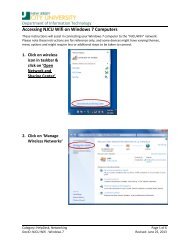
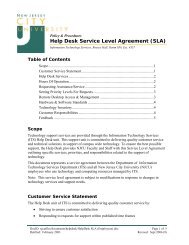




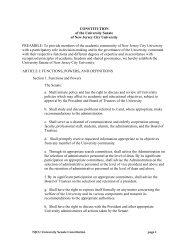

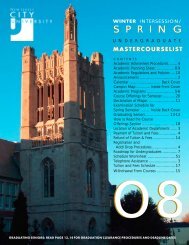
![UACHS 9th English Unit- Feed[1] - New Jersey City University](https://img.yumpu.com/46563190/1/190x245/uachs-9th-english-unit-feed1-new-jersey-city-university.jpg?quality=85)
